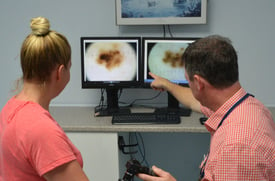What is skin imaging and why is it important?
What is skin imaging and why is it an important part of your regular skin check?
We are often told to monitor our skin at home and be vigilant for new or changing moles that might indicate skin cancer. While this leads to the majority of skin cancers being first noticed by you or your partner, the only way to get an accurate diagnosis (and catch all the skin cancers you didn't find!) is through a regular professional skin check, which may include skin imaging.
During a full-body skin examination, your doctor will use a small tool called a dermatoscope to assess your skin from head to toe. Dermatoscopes come in all shapes and sizes but generally have the same function: to enable the doctor to "see through" the top layers of skin and analyse any abnormal cell patterns that are invisible to the naked eye which could indicate skin cancer. Dermoscopy is the world standard in skin cancer detection and you should ensure that the doctor performing your regular skin checks has certifications in dermoscopy or skin cancer medicine.
 As part of a comprehensive approach to diagnosing and managing skin cancer, your doctor may also take photographs of your entire skin surface or any suspicious lesions on your body. Skin imaging is performed so that past photographs can be compared with future ones, so as to monitor any changes in the size, shape or colour of your moles. As new or changing lesions are the first indication of skin cancer, skin imaging is at the forefront of precise and early diagnosis.
As part of a comprehensive approach to diagnosing and managing skin cancer, your doctor may also take photographs of your entire skin surface or any suspicious lesions on your body. Skin imaging is performed so that past photographs can be compared with future ones, so as to monitor any changes in the size, shape or colour of your moles. As new or changing lesions are the first indication of skin cancer, skin imaging is at the forefront of precise and early diagnosis.
Skin imaging helps to accurately track changes over time. High-resolution digital images can produce potentially life-saving results as they enable side-by-side comparisons at follow-up appointments, revealing subtle changes in your skin that neither you nor your doctor had noticed.
The process is quick and painless, and you can usually follow the exam on the screen. Your doctor will still use a dermatoscope to thoroughly examine your skin, ensuring that skin cancer can be detected at its earliest stage when it is most manageable and requires least invasive treatment.
- Tags:
- Detection
